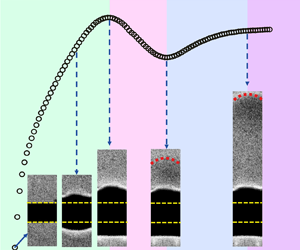No CrossRef data available.
Article contents
Formation and evolution of laminar thermal structures: correlation to the thermal boundary layer and effects of heating time
Published online by Cambridge University Press: 08 April 2024
Abstract

We report an experimental study of the formation and evolution of laminar thermal structures generated by a small heat source, with a focus on their correlation to the thermal boundary layer and effects of heating time  $t_{heat}$. The experiments are performed over the flux Rayleigh number (
$t_{heat}$. The experiments are performed over the flux Rayleigh number ( $Ra_f$) range
$Ra_f$) range  $2.1\times 10^6 \leq Ra_f \leq 3.6\times 10^{7}$ and the Prandtl number (
$2.1\times 10^6 \leq Ra_f \leq 3.6\times 10^{7}$ and the Prandtl number ( $Pr$) range
$Pr$) range  $28.6 \leq Pr \leq 904.7$. The corresponding Rayleigh number (
$28.6 \leq Pr \leq 904.7$. The corresponding Rayleigh number ( $Ra= t_{heat}\,Ra_{f}/\tau _0\,Pr$) range is
$Ra= t_{heat}\,Ra_{f}/\tau _0\,Pr$) range is  $900 \leq Ra \leq 4\times 10^{4}$, where
$900 \leq Ra \leq 4\times 10^{4}$, where  $\tau _0$ is a diffusion time scale. For thermal structures generated by continuous heating (i.e. starting plumes), their formation process exists three characteristic times that are well reflected by changes in the thermal boundary layer thickness. These characteristic times, denoted as
$\tau _0$ is a diffusion time scale. For thermal structures generated by continuous heating (i.e. starting plumes), their formation process exists three characteristic times that are well reflected by changes in the thermal boundary layer thickness. These characteristic times, denoted as  $t_{emit}$,
$t_{emit}$,  $t_{recover}$ and
$t_{recover}$ and  $t_{static}$, correspond to the moments when the plume emission begins and completes, and when the thermal boundary layer becomes quasi-static, respectively. Their
$t_{static}$, correspond to the moments when the plume emission begins and completes, and when the thermal boundary layer becomes quasi-static, respectively. Their  $Ra_f$–
$Ra_f$– $Pr$ dependencies are found to be
$Pr$ dependencies are found to be  $t_{emit}/\tau _0\sim Ra_f^{-0.41}\,Pr^{0.41}$,
$t_{emit}/\tau _0\sim Ra_f^{-0.41}\,Pr^{0.41}$,  $t_{recover}/\tau _0\sim Ra_f^{-0.48}\,Pr^{0.48}$ and
$t_{recover}/\tau _0\sim Ra_f^{-0.48}\,Pr^{0.48}$ and  $t_{static}/\tau _0\sim Ra_f^{-0.49}\,Pr^{0.33}$, respectively. Thermal structures generated by finite
$t_{static}/\tau _0\sim Ra_f^{-0.49}\,Pr^{0.33}$, respectively. Thermal structures generated by finite  $t_{heat}$ exhibit similar evolution dynamics once
$t_{heat}$ exhibit similar evolution dynamics once  $t_{heat} \ge t_{emit}$, with the accelerating stage behaving like starting plumes and the decay stage like thermals (i.e. a finite amount of buoyant fluids). It is further found that their maximum rising velocity experiences a transition in the
$t_{heat} \ge t_{emit}$, with the accelerating stage behaving like starting plumes and the decay stage like thermals (i.e. a finite amount of buoyant fluids). It is further found that their maximum rising velocity experiences a transition in the  $Ra$-dependence from
$Ra$-dependence from  $Ra$ to
$Ra$ to  $(Ra\ln Ra)^{0.5}$ at
$(Ra\ln Ra)^{0.5}$ at  $Ra \simeq 6000$; and their maximum acceleration reaches the value of starting plumes at
$Ra \simeq 6000$; and their maximum acceleration reaches the value of starting plumes at  $t_{heat}\simeq t_{recover}$, and remains unchanged for larger
$t_{heat}\simeq t_{recover}$, and remains unchanged for larger  $t_{heat}$. In particular, the maximum rising velocity for the cases with
$t_{heat}$. In particular, the maximum rising velocity for the cases with  $t_{heat} = t_{recover}$ follows a scaling relation
$t_{heat} = t_{recover}$ follows a scaling relation  $Ra_f^{0.37}\,Pr^{-0.37}$, in contrast to the relation
$Ra_f^{0.37}\,Pr^{-0.37}$, in contrast to the relation  $Ra_f^{0.48}\,Pr^{-0.48}$ for starting plumes. This study provides a more comprehensive understanding of laminar thermal structures, which are relevant to a range of processes in nature and laboratory systems such as Rayleigh–Bénard convection.
$Ra_f^{0.48}\,Pr^{-0.48}$ for starting plumes. This study provides a more comprehensive understanding of laminar thermal structures, which are relevant to a range of processes in nature and laboratory systems such as Rayleigh–Bénard convection.
JFM classification
- Type
- JFM Papers
- Information
- Copyright
- © The Author(s), 2024. Published by Cambridge University Press





